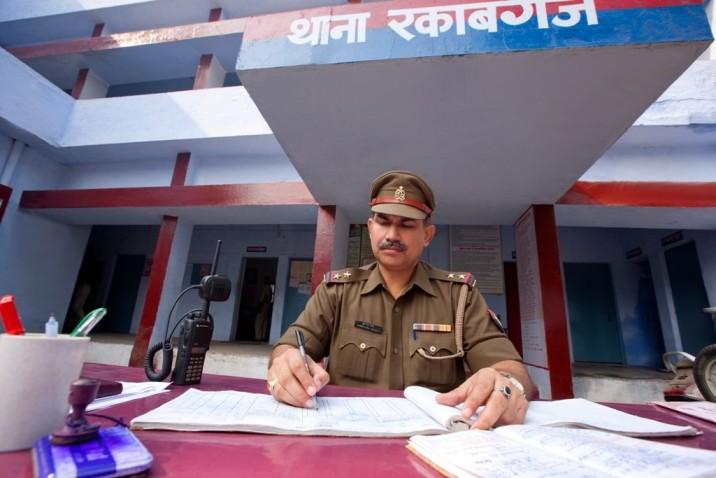Reprinted by permission from VoxDev; Authors.
Gender-based violence (GBV) is a large and growing problem worldwide, exacerbated by conditions created by the pandemic. A massive impediment to tackling GBV is that a vast majority of incidents are neither reported to, nor registered by, law enforcement. While social stigma may be one reason that women under-report cases, a lack of trust in and the poor responsiveness the police also plays a large role. The police, for their part, are often dismissive of women’s concerns, and face disincentives to register women’s cases including capacity and resource constraints as well as political pressure to keep recorded rates of violence against women low (CHRI 2020, Jassal 2021).
In order to address these issues, governments have introduced various gender-targeted police reforms, falling in two broad categories: establishing gender-segregated services such as all-women’s police stations, or increasing the representation of women within the police force. Both types of intervention rest on the assumption that female officers will be more responsive to female complainants, and that women, in turn, will be more likely to approach other women in the police. These interventions, however, have rarely been rigorously tested, and the limited evidence that exists suggests at best mixed success. Studies of all-women police stations—for example in Brazil and India—reveal that women may be further marginalized since they are denied recourse to regular, mixed-gender stations which tend to be more proximate as well as better resourced (Santos 2005, Jassal 2020). And while some studies, mainly in the Global North, find that reporting and arrests for GBV do increase with the hiring of more female officers (Meier and Nicholson-Crotty 2006; Miller and Segal 2019), others, particularly in more capacity constrained settings, find no such impacts (Karim 2020).
The intervention: Women’s Help Desks
In our study (Sukhtankar et al. 2022), we worked with the police in India to evaluate a gender-targeted intervention in the form of Women’s Help Desks (WHDs) to explore how law enforcement might be made more responsive and accountable to women. WHDs are dedicated spaces in local police stations staffed by officers trained to assist women in registering cases and pursuing other forms of legal and social assistance. This intervention was coupled with sustained police training and community outreach programs. The reform aimed to mainstream (rather than segregate) police efforts on GBV by establishing help desks within regular stations (rather than all-women stations), while in some stations also increasing women’s representation within the police force.
India provides an informative context in which to study this type of intervention: it ranks near the bottom on global measures of gender equality (140/156 countries), and has high rates of GBV. It is also a context with entrenched patriarchal norms in the police as well as society, and a very low proportion (10%) of women working in the police force. The state we worked in—Madhya Pradesh—is broadly representative of the highly populous north-central belt of India. Women in Madhya Pradesh face significant barriers to reporting, and registration of cases of GBV is extremely low (Neville et al. 2015). These trends were visible in our baseline data, where basically zero civil cases and fewer than four criminal cases of GBV were registered per police station—each with a jurisdiction of 130,000 people on average—per month.
The WHD intervention consisted of four components:
- The creation of physical spaces within stations, designed to offer some privacy to women complainants.
- The provision of standard operating procedures on how to receive and assist women complainants, along with training on these procedures and on gender sensitization for officers assigned to run the WHDs as well as to other officers in the station.
- Outreach to local women’s networks with the aim of socially-embedding the WHDs in their surrounding communities.
- The allocation of female officers assigned to run the WHDs.

Measuring the impact of Women’s Help Desks
We evaluated the impact of this bundle of reforms, which were implemented in 12 out of 51 districts of Madhya Pradesh, across 180 police stations serving a total population of 24 million.1 Those 180 stations were randomized into three groups: 61 stations received the first three components of the intervention, 59 received all four components (including the assignment of female officers to run the WHDs), and 60 were in the control group.
Although there were some gaps, the intervention was generally well implemented and monitored regularly by senior police officers:
- 94% of stations in the treatment groups created a physical space for the WHDs;
- Every treatment station received at least some training (although only 67% conducted full training at the station level);
- 87% held at least one community outreach event;
- 90% of the treatment group assigned to have a female officer run the desk complied with this requirement.
To assess the impact of the intervention, we collected five main sources of quantitative data: administrative data on crimes registered; the rates at which women visited police stations through CCTV footage from pre-existing cameras at the entrance to stations; a user survey of visitors to the stations to measure satisfaction; a survey of police officers to assess perception towards policing and GBV; and a survey of citizens living in police station jurisdictions to measure actual rates of GBV as well as citizen perceptions of safety and the police. These were complemented by systematic qualitative data collected from police stations in all three groups of the study.
Effects on the responsiveness to gender-based violence
Impacts on registration of cases were dramatic: on average, treatment group stations registered 1.5 civil cases (filed under India’s Protection of Women from Domestic Violence Act) per month. While this is still a small number, it eclipses the almost zero (0.05) registered in the control group where officers had very limited knowledge of how to file such civil cases. Treatment group stations also registered more criminal cases of GBV—the bread and butter of policing, filed under Indian Penal Code—posting an average of 4.4 per month versus 3.8 in the control group. In total, treatment group stations registered an additional 1,905 additional civil cases and 3,360 criminal cases over the course of the study. These increases in case registration represent a small but critical first step in access to justice for a large number of women, without which further legal action and access to the judicial system is not possible. Notably, the increase in criminal cases—the filing of which requires significant investments of police time and resources—was entirely driven by the treatment group in which the WHDs had (randomly) been assigned to be run by a woman, highlighting the particular importance of female officers willing to invest their time and energy.
These increases in case registrations were neither a result of increased actual crime (as measured by the citizen survey), nor of an increase in reporting by citizens (as measured by the number of women approaching police stations using CCTV data). Neither of these results are surprising: it is unlikely that the short duration of the intervention (11 months of full implementation) would have affected crime directly, and large police jurisdictions meant that the community outreach activities reached only a small fraction of the population.
Our user survey revealed that women visitors were more likely to express comfort in their visits in treatment stations staffed with better trained personnel.
Instead, the increased registrations were a result of changes in police behaviour that resulted in greater responsiveness to women visitors to the station. Our user survey revealed that women visitors were slightly more likely to express comfort in their visits, and were more likely to be satisfied and feel respected in treatment stations that were better trained. Moreover, while police attitudes on gender were on the whole were not affected by the intervention, female officers in treatment stations became more likely to believe women than their counterparts in control stations (countering a widely held narrative among the police that women often file “false” complaints against men).
Policy takeaways
Our results suggest that gender-targeted police services such as a specialised help desk housed within regular, mixed-gender police stations can improve the responsiveness of police to women, when combined with mainstream support and training. This is true even in resource and capacity constrained settings. As importantly, our results reveal that increasing gender representation within the police matters; female officers were at the fore in stations with increased criminal case registration, and female officers also appeared to be most sensitive to help desk training. These findings are of critical importance in a context where many states have pledged to reserve 30 percent of new police jobs for women. More research is required to explore the conditions that best build and support the agency of female officers.
Of course the police, governments, and society can and should do much more to assist women rather than merely registering criminal or civil legal cases. Policing, moreover, is but one potential—and often fraught and inadequate—avenue through which to tackle GBV. Yet, listening to women and registering their cases is a critical first step in ensuring that perpetrators cannot behave with impunity. The Madhya Pradesh police have recently scaled up the WHD intervention to practically all (950) police stations across the state: studying this scale-up will help us understand the extent to which the impacts may be sustained.
—
References
- CHRI – Commonwealth Human Rights Initiative (2015), “Crime Victimisation and Safety Perception: A Public Survey of Delhi and Mumbai”, New Delhi.
- Jassal, Nirvikar (2020), “Gender, Law Enforcement, and Access to Justice: Evidence from All-Women Police Stations in India”, American Political Science Review 114(4): 1035-1054. Available here.
- Jassal, Nirvikar (2021), “Segregation as Efficiency? Group-Specific Institutions in North India”, The Journal of Asian Studies 80(3): 631-661. Available here.
- Karim, Sabrina (2020), “Relational state building in areas of limited statehood: Experimental evidence on the attitudes of the police”, American Political Science Review 114(2): 536-551.
- Meier, Kenneth J and Nicholson‐Crotty, Jill (2006), “Gender, representative bureaucracy, and law enforcement: The case of sexual assault”, Public Administration Review 66(6): 850-860.
- Miller, Amalia R and Segal, Carmit (2019), “Do female officers improve law enforcement quality? Effects on crime reporting and domestic violence”, The Review of Economic Studies 86(5): 2220-2247.
- Neville, S, M Hilker, M Humphreys, S Husain, S Khan and S Lindsey (2015), Evaluation of the Madhya Pradesh Safe Cities Initiative, Baseline Report, London: DFID.
- Santos, Cecilia MacDowell (2005), Women’s Police Stations: Gender, Violence, and Justice in São Paulo, Brazil, Palgrave Macmillan.
- Sukhtankar S, G Kruks-Wisner and A Mangla (2022), “Policing in patriarchy: An experimental evaluation of reforms to improve police responsiveness to women in India”, Science 8;377(6602):191-8. Available here.
Endnotes
- Districts were selected to be broadly representative of the state’s diverse geography and socio-economics, but skewed somewhat urban due to the inclusion of the state’s four largest cities. Within these districts, the 180 study stations were randomly selected, after excluding those that were either fully rural or specialized (e.g. all-women stations).







